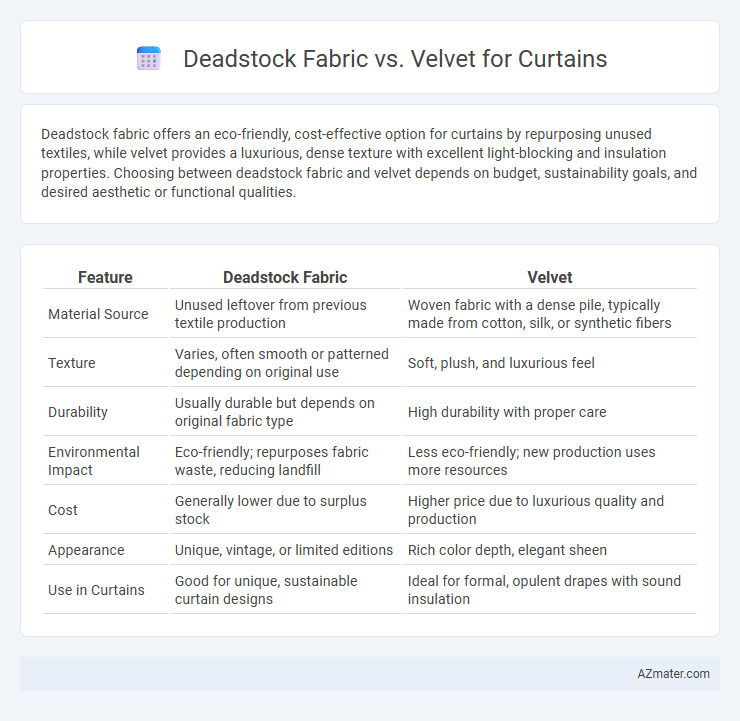Deadstock fabric offers an eco-friendly, cost-effective option for curtains by repurposing unused textiles, while velvet provides a luxurious, dense texture with excellent light-blocking and insulation properties. Choosing between deadstock fabric and velvet depends on budget, sustainability goals, and desired aesthetic or functional qualities.
Table of Comparison
| Feature | Deadstock Fabric | Velvet |
|---|---|---|
| Material Source | Unused leftover from previous textile production | Woven fabric with a dense pile, typically made from cotton, silk, or synthetic fibers |
| Texture | Varies, often smooth or patterned depending on original use | Soft, plush, and luxurious feel |
| Durability | Usually durable but depends on original fabric type | High durability with proper care |
| Environmental Impact | Eco-friendly; repurposes fabric waste, reducing landfill | Less eco-friendly; new production uses more resources |
| Cost | Generally lower due to surplus stock | Higher price due to luxurious quality and production |
| Appearance | Unique, vintage, or limited editions | Rich color depth, elegant sheen |
| Use in Curtains | Good for unique, sustainable curtain designs | Ideal for formal, opulent drapes with sound insulation |
Introduction: Choosing the Right Fabric for Curtains
Deadstock fabric offers sustainability by repurposing surplus textile stock, providing unique patterns and textures ideal for environmentally conscious curtain designs. Velvet, known for its rich texture and luxurious appearance, enhances room ambiance with its soft pile and excellent light-blocking properties. Selecting between deadstock fabric and velvet depends on preferences for eco-friendliness, aesthetic appeal, and functional qualities like insulation and durability.
Understanding Deadstock Fabric: Definition and Origins
Deadstock fabric refers to unused, leftover textile material from previous production runs or discontinued collections, often sourced from fashion houses or textile mills. This fabric's origins lie in excess inventory that would otherwise be discarded, making it a sustainable choice for curtain making due to its limited availability and unique character. In contrast, velvet is a specific woven fabric characterized by its soft, plush texture, commonly used for curtains to add luxury and warmth, but it may not always align with sustainable practices like deadstock fabric does.
What is Velvet? History and Characteristics
Velvet is a luxurious textile characterized by its dense pile of evenly cut fibers, creating a soft, smooth surface with a shimmering appearance. Originating in the Middle Ages, velvet was historically crafted from silk and associated with royalty and nobility due to its intricate weaving process and rich texture. Its characteristics include a distinctive plush feel, excellent durability, and the ability to catch light, making it a popular choice for elegant curtains and upholstery.
Sustainability: Deadstock Fabric vs Velvet
Deadstock fabric significantly reduces textile waste by repurposing unused materials from previous production runs, making it a sustainable choice for curtains. Velvet, while luxurious, often requires intensive water and energy consumption during manufacturing, which can negatively impact environmental sustainability. Choosing deadstock fabric supports circular fashion principles and minimizes the ecological footprint compared to traditional velvet curtains.
Visual Appeal and Texture Comparison
Deadstock fabric offers unique visual appeal with vintage patterns and textures often unavailable in new textiles, providing eco-friendly and exclusive curtain options. Velvet delivers a luxurious, soft texture with a rich sheen that enhances light absorption and adds depth to any room, ideal for creating opulent, warm atmospheres. Comparing texture, deadstock fabric tends to have more varied hand-feel depending on its origin, while velvet consistently provides a plush, smooth surface that drapes elegantly.
Durability and Longevity in Home Use
Deadstock fabric often offers superior durability due to its original manufacturing quality and untreated fibers, making it resilient against wear and fading in home use. Velvet, while luxurious and soft, requires careful maintenance to preserve its plush texture and can show wear more quickly in high-traffic areas. For long-lasting curtains, deadstock fabric provides a practical choice with its robust weave, whereas velvet excels in aesthetic appeal but demands more upkeep to maintain longevity.
Maintenance: Cleaning and Care Tips
Deadstock fabric offers durability and often requires gentle hand washing or dry cleaning to preserve its unique vintage texture, while velvet curtains demand regular vacuuming with a brush attachment to prevent dust buildup and professional steaming to maintain their plush appearance. Both materials avoid harsh chemicals and bleach, but velvet is more prone to crushing and staining, necessitating prompt spot cleaning with mild detergent solutions. Maintaining the fabric's integrity involves rotating panels to ensure even exposure to sunlight and periodic airing to reduce moisture and odors.
Cost Analysis: Affordability and Value
Deadstock fabric offers a cost-effective option for curtains, often priced lower due to surplus inventory, making it an affordable choice without compromising unique patterns or textures. Velvet, while typically more expensive, provides superior durability, luxury, and rich texture that justifies the higher investment through long-term value and enhanced aesthetic appeal. Considering budget constraints and desired elegance, deadstock fabric suits economical projects, whereas velvet delivers premium quality and timeless style for high-end curtain applications.
Light Control and Insulation Properties
Deadstock fabric offers superior light control due to its dense weave and heavier weight, effectively blocking out sunlight and reducing glare in curtains. Velvet, known for its plush texture and thickness, provides excellent insulation properties by trapping heat and maintaining room temperature, enhancing energy efficiency. Both fabrics improve privacy, but velvet excels in thermal insulation while deadstock is ideal for maximum light blockage.
Which Fabric is Best for Your Curtains?
Deadstock fabric offers unique, often vintage patterns and sustainable appeal, making it ideal for eco-conscious homeowners seeking distinctive curtain designs. Velvet provides a luxurious texture, excellent light-blocking properties, and superior insulation, perfect for creating a cozy, elegant atmosphere. Choosing the best curtain fabric depends on your preference for sustainability and uniqueness versus warmth and opulence.

Infographic: Deadstock Fabric vs Velvet for Curtain
 azmater.com
azmater.com